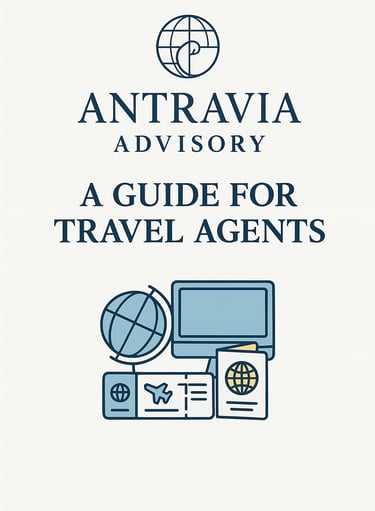
Travel Agent Finance Guide 2025: 4.1 Forecasting and Planning for Growth
Part 4.1 of the Antravia Travel Agent Finance Guide - Learn why forward-looking cash flow forecasts are essential for travel agents. Discover how to use booking patterns, seasonality, and pipeline data to plan revenue, build reserves, and support expansion into new markets.
ANTRAVIA TRAVEL AGENT GUIDE
1/13/20256 min read


Part 4: Building Financial Resilience
In the next part of our Travel Agent Finance Guide, we move beyond day-to-day accounting and look at the bigger picture: how to build a financially resilient travel business. This section will cover how to plan for growth, manage working capital, and prepare for shocks such as supplier failures or sudden drops in demand. We will also address financing options, from credit lines to investor funding, and examine how to use financial reporting to guide long-term decisions. The goal is to give travel agents a framework for sustainability, so you can not only survive but thrive in a constantly shifting industry.
4.1 Forecasting and Planning for Growth
Why forward-looking cash flow forecasts are critical
Using booking patterns, seasonality, and pipeline data to anticipate revenue
Planning for expansion into new markets or niches
Setting aside reserves during strong months to cushion weaker periods
4.2 Working Capital and Liquidity Management
Understanding the timing gap between client deposits and supplier payments
Maintaining liquidity to cover chargebacks, refunds, or delayed commissions
Best practices for separating operating capital from client money
Using short-term reserves and credit responsibly
4.3 Financing Options for Travel Agents
Credit lines and small business loans: what banks actually look for
SBA loans and financing programs in the U.S.
Investor funding: when it makes sense, when it doesn’t
Host agency advances and supplier credit terms as hidden financing sources
Surviving the first years
4.4 Preparing for Industry Shocks
Supplier insolvency: how to protect clients and your own cash flow
Sudden demand drops (pandemics, geopolitical events, recessions)
Insurance strategies: business interruption, professional liability, cyber risk
Building flexibility into your cost base so you can adapt quickly
4.5 Using Financial Reporting for Strategy
How to use profit and loss, balance sheet, and cash flow together
Identifying trends: revenue per booking, cancellation ratios, client lifetime value
Moving from reactive to proactive decision-making
Using financial data to position your agency for long-term sustainability


Part 4.1 Forecasting and Planning for Growth
(This section focuses on forward-looking financial planning, such ascash flow forecasts, reserves, and income projections. For structural growth strategies such as hiring, systems, and compliance, see Part 3.4)
Forecasting is often treated as something only large companies do, but for a travel agency it is one of the most important habits to build. Without a forward-looking view of cash, you risk being caught out when commissions are delayed, seasonality creates sudden dips, or expansion costs hit before revenue has caught up. A clear forecast helps you decide not only whether you can pay bills but also whether you are ready to grow.
Why do forecasts matter?
Many agents rely on instinct and assume that if bookings are flowing, cash will follow. The reality is, of course, more complex. Client deposits may arrive months before you have to pay suppliers, and commission income often lags until after the trip has been taken. Without a structured forecast, the timing gap between receipts and payments can leave you exposed, even in what feels like a strong sales year.
A rolling cash flow forecast, updated monthly, is far more useful than a fixed annual budget. It allows you to see six to twelve months ahead, incorporating new bookings as they are confirmed and adjusting for cancellations or refunds. This forward-looking discipline gives you early warning of pressure points and lets you act before liquidity becomes critical. In practice, a good forecast is what gives you the ability to withstand shocks, such as supplier insolvency or sudden drops in demand, because you already know where the cash strain will appear.
Practical inputs for agents
The strongest forecasts are built on data you already hold:
Booking patterns: Analyse how far ahead clients book. A family trip to Europe may be planned 9 months out, while a Caribbean cruise could be locked in a year in advance. Domestic breaks may be booked with only a few weeks’ notice. Each category creates different timing for deposits and balances.
Seasonality: Look at your commission reports from the last two to three years. If 40% of income lands in the first quarter as clients plan summer, your forecast should show a cash surplus early in the year and a tighter position in autumn.
Pipeline data: Hosted agents can pull pipeline and commission projections from their host dashboards. Independent agents should keep a live spreadsheet of quotes, conversion rates, and confirmed trips. Even conservative assumptions, say, a 25% close rate on outstanding quotes, will improve your forecast accuracy.
Planning for expansion
Forecasting is also how you model whether you can afford to expand. Entering a new niche, such as luxury cruises or corporate travel, usually comes with upfront marketing spend, training, and potentially new systems. Expanding geographically may mean licensing fees, bonding, or local registrations. These costs rarely pay back immediately. Building them into a forecast lets you see if your current reserves can absorb the initial outlay or whether you should delay until cash strength improves.
Building reserves
Perhaps the most practical application of forecasting is discipline around reserves. When peak season delivers strong cash flow, it is tempting to invest it all in new advertising or treat it as profit. Resilient agencies deliberately move part of those surpluses into a reserve account. This can be as simple as transferring 10%–20% of commissions earned in peak months into a separate bank account. When the inevitable low season arrives, those funds provide a buffer to keep operations stable without resorting to emergency credit.
Example
Take an example of a small independent agency: in January it collects $100,000 in deposits for summer holidays. Supplier balances of $60,000 are not due until April, and commission of $20,000 will only be received after clients travel in July. On paper the agency feels flush in January, but without a forecast it risks overspending. By forecasting, the owner sees that April will require a large cash outflow before new deposits arrive, and July income will not hit until months later. By moving $25,000 into a reserve account early, the agency can cover the April supplier payments and still maintain liquidity if cancellations occur.
Tools to make it practical
Many agents start in Excel, building a simple 12-month cash flow with three columns: inflows, outflows, and balance. Over time, you can upgrade:
Accounting software add-ons like Float (for Xero and QuickBooks) automate rolling cash flows.
Host dashboards sometimes provide forward commission reports, which can be exported and linked into your forecast.
CRM data can be integrated to show pipeline conversions and expected revenue.
The tool itself is less important than the habit. A forecast you update monthly, even if it is only a spreadsheet, will keep your business more resilient than any complex system left unused.




References for Part 4.1 Forecasting and Planning for Growth
U.S. Small Business Administration (SBA). Prepare a Cash Flow Forecast. Available at: https://www.sba.gov/business-guide/manage-your-business/prepare-cash-flow-forecast
Chartered Institute of Management Accountants (CIMA). Cash Flow Forecasting: The Importance of Looking Ahead. Available at: https://www.cimaglobal.com/Research--Insight/Cash-Flow-Forecasting
Association of Chartered Certified Accountants (ACCA). Cash Flow: The Businesses’ Lifeline. Available at: https://www.accaglobal.com/gb/en/professional-insights/global-economics/cash-flow.html
HighRadius. How Are Cash Flow Forecasts Different from Cash Flow Statements? Available at: https://www.highradius.com/resources/Blog/how-are-cash-flow-forecasts-different-from-cash-flow-statements
Talentia Software. Unveiling the Power of Cash Flow Forecasting in 5 Steps. Available at: https://www.talentia-software.com/en/unveiling-the-power-of-cash-flow-forecasting-in-5-steps
CashFlowTool. Cash Flow Forecasting for Small Businesses. Available at: https://www.cashflowtool.com
Cash Flow Frog. Cash Flow Forecasting Software for Small Business. Available at: https://cashflowfrog.com


Acknowledgements
Antravia would like to thank our consulting clients and industry partners who generously shared their time, insights, and real-world case studies. All client examples have been anonymized and edited for clarity, but they are based on true advisory engagements and reflect real decisions, challenges, and financial outcomes from across the travel industry.
Antravia Advisory
Where Travel Meets Smart Finance
Email:
Contact us:
Antravia LLC
© 2025. All rights reserved. | Disclaimer | Privacy Policy | Terms of Use | Accessibility Statement
Antravia.com - Global site of the Antravia Group.
Antravia.com | Antravia.co.uk | Antravia.ae |
Finance.travel | Tax.travel | Consultancy.travel | Vat.travel | Vat.claims |
USSales.tax | EuroVAT.tax | UKVAT.tax |
contact@antravia.com
Antravia LLC
4539 N 22nd St., Ste. N
Phoenix
Arizona
85016
